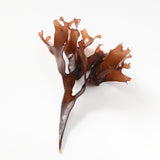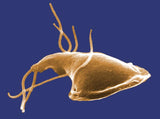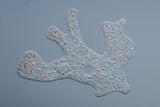News
Spring cleaning in your biology closet March 04 2020, 0 Comments
It’s that time of year when the urge to put things in order can strike. You may have a closet with a lot of biology materials that you want to evaluate. Here are my suggestions for things to throw out. You may not want to discard the whole material just because it has flawed content provided it is feasible to fix the problems.
In the animal kingdom materials, if you find anything that has the phylum Coelenterata, please remove that name or cover it. Biologists haven’t used it for more than 30 years. That phylum was split into two others when biologists discovered that it held two unrelated groups. The two lineages are called phylum Cnidaria (anemones, corals, and jellyfish) and phylum Ctenophora (comb jellies). It is likely that you can cover over “Coelenterata” and add the label “Cnidaria.” Just make sure that you don’t have comb jellies in with your cnidarians.
Another no-no for the animal kingdom is showing protozoa along with the animals. This goes back to the two-kingdom idea of classification, and biologists and biology textbooks haven’t grouped protozoans with animals in more than 40 years.
If you find a chart that is labeled “Non-Chordates,” change the title to “Invertebrates.” Maybe “non-Chordate” was useful in the past, but biologists use “invertebrate” far more often. I searched books on Amazon.com using “non-chordates,” and I got six titles, all published outside the US. I searched “invertebrates,” and got over 6000 titles. A non-chordate chart isn’t likely to show current information, so it is time to recycle it or at least recycle the images and add new text.
The relationships between the phyla of animals solidified about 15 years ago. In biology, classification has morphed into systematics, which all about relationships and shared common ancestry. The details of this would take several blogs so I will simply say that the arthropods are related to the nematodes, and the mollusks are related to the annelids. Arthropods were once grouped with annelids, but that is no longer considered valid. Can you add something to your animal kingdom chart that shows which phyla are closely related? See my book, Kingdoms of Life Connected, for help if your animal kingdom chart needs a redo. https://big-picture-science.myshopify.com/collections/frontpage/products/kingdoms-of-life-connected-second-edition. It is also available as an ebook (pdf).
Dig back into the cobwebs in the botany section of your closet. If your chart of the plant has club mosses separated from the fern clade – whisk ferns, horsetails, and ferns – you have a good representation of life’s diversity. The chart from InPrint for Children is a good example. https://big-picture-science.myshopify.com/collections/montessori-botany-materials/products/plant-kingdom-chart . Another mark of a current material – it should use the term “eudicots” instead of “dicots.” If your chart has phylum names, it is quite possible that many of the names are obsolete. Many botanists no longer use phyla or division names. Instead, they use lineage names, and sometimes a common name is all you need. I have a graduate level botany textbook that uses no phylum/division names.
If your plant kingdom chart has fungi or bacteria on it, the time has come to do some serious pruning. Those two have to go to their own charts. If the image of a fungus appears on a plant kingdom chart, that’s what children will remember even if you say that it doesn’t belong there. The fungus kingdom is a sister to the animal kingdom. In nature, fungi and plants are partners, but on classification charts, they shouldn’t hang around together.
If you have a Five Kingdoms chart, file it under the history of biology. It should NOT be the first thing children see as they study the diversity of life. The Tree of Life is the place to start.
How about your timeline of life? This is a difficult material to do well, and there are many bad attempts out there. Does your timeline show several red lines coming together (converging)? That’s the traditional style, but lineages do not converge (fuse together); they diverge (split apart). Maybe you could salvage the images and redo the timeline without the misleading lines. Check the dates for the fossils because there are several in the wrong place on the older timelines.
Does your timeline of life have photos of extant animals or plants in prehistoric times? This gives a very wrong impression. I’ve seen a timeline that had “First marsupial” and a picture of a kangaroo. This is just like saying “First eutherian (placental) mammal” and showing a picture of a horse. Both the kangaroo and the horse evolved within the last few million years. They are both adapted to live on grasslands and open shrub lands, where resources are spread out, and there is little cover from predators. Therefore both are good at moving quickly over long distances. Neither one of them belongs in the Mesozoic Era on a timeline of life. Mesozoic mammals were much smaller and less specialized.
Does your timeline have the five major extinctions? And does it have ice ages in the right places? The older charts used ice to symbolize all extinctions, although that wasn’t the cause in most of them. The five major extinctions come at the end of the Ordovician, Devonian, Permian, Triassic, and Cretaceous Periods. They are such important shapers of life that they are essential to a good timeline.
If all this correcting sounds like too much to do, remember that you are doing it for the children. They need current information and a foundation that they can use in their future studies. There is no point in giving them science “information” that they will never see outside a Montessori classroom.
How do you divide the eukaryotes? September 19 2019, 0 Comments
If I asked you how you would divide the eukaryotes into groups, what would you say? Many people would say protists, fungi, animals, and plants. This is the idea presented in Five (or Six) Kingdoms classification. There is a more enlightening way to divide the eukaryotes, one that students currently see in introductory college courses.
The DNA revolution and the development of systematics rather than plain classification have given us a new view. Systematics includes the relationships between taxonomic categories instead of listing them with no information about their shared ancestors. It is a young science that has produced many changes and will likely produce many more.
This is not to say that we don’t have useable information right now. The largest categories of eukaryotes have been defined, and they are called the eukaryotic supergroups. There are four of them presently, and so the eukaryotes can be divided into four groups. Here’s an introduction to the archaeplastida, SAR, excavata, and unikonts aka Amorphea.
Archaeplastida is the lineage that acquired the first chloroplast. Its name means “ancient plastids.” A plastid is a type of organelle in a eukaryotic cell, and the category includes the chloroplast, whose name means “green body.” The archaeplastida lineage includes red algae and green algae, along with the embryophytes or land plants, which evolved from a green alga. This lineage is the only one that incorporated an ancient cyanobacterium into its cells. The origin of the chloroplasts in other lineages is a more complicated story.


The SAR lineage is named for the three main branches within it, stramenopiles, alveolates, and rhizarians. These lineages were defined independently and then researchers gathered enough evidence to conclude that they share a common ancestor. The stramenopiles (aka chromists or heterokonts) include brown algae, golden algae, diatoms, and water molds. Alveolates include dinoflagellates, apicomplexans (parasites such as malaria), and ciliates. The rhizarians include foraminiferans and radiolarians, single cell organisms that build amazing outer shells called tests.


And where did these branches of life get their chloroplasts? It seems that chloroplasts are NOT easy to acquire. Apparently, it is easier to take one from another cell than to acquire one by eating a cyanobacterium. An ancestor of the stramenopiles and alveolates probably ate a red alga and kept its chloroplasts. Euglenas, which we meet below, got their chloroplasts from a green alga.
The third eukaryotic supergroup is the excavata, also called the excavates, but I see potential for confusion between the word as a noun vs. a verb. The lineage is named for a groove that looks like it has been excavated from the cells of some members. The excavata include the euglenas, which are free-living, and the trypanosomes, which are parasites. Other members of this group include the parasite Giardia and organisms that live in the guts of termites and help them break down cellulose. These have reduced mitochondria, so small that they were first described as lacking mitochondria.



I know you have been waiting for the last of the four supergroups, our own lineage, the unikonts (“single flagellum”) also known as the Amorphea (“having no form”). “Wait a minute,” you may be thinking, “we definitely have form.” The amoebas that belong to this lineage do not, however. The Amoebozoa lineage includes most of the slime molds or social amoebas as well as the single cell ones. Some of the latter build hard coverings (tests) for themselves. The other members of the unikonts are the fungus kingdom and the animal kingdom, which are sister kingdoms, having shared a common ancestor right before they branched off. There are other single cell organisms that are related to animals and fungi as well.



As you can see, the old protist kingdom had many different lineages of life shoe-horned into it, and the kingdoms that developed from its members were chopped off and boxed separately from it in the Five (or Six) Kingdoms scheme.
Why should you or your children learn about the supergroups of eukaryotes? It gives you a richer view of life and one that your children will see in their future studies. Will the names stay the same? Maybe, or maybe not, but these are the names in current college biology books, and it is worthwhile to learn about them and their members now.
Enjoy your explorations of the living world!
Priscilla



